Is it possible to eat pink watermelon and why is it so
Buying melons can be compared to a lottery, especially at the beginning of the sales season. The expected moment of cutting can unpleasantly upset the pale pink core. However, it is not always necessary to throw away the fruit: there are varieties that have exactly this color of the edible part. There are several ways to tell the difference between nitrate watermelon and a breeder hybrid with pink flesh.
The content of the article
- How pink watermelons appeared
- What is the difference between pink watermelon and red
- Characteristics, useful properties and composition of pink watermelon
- Main varieties and hybrids
- How to choose the right pink watermelon
- What if an ordinary watermelon turned out to be not red, but pink with white veins
- Conclusion
How pink watermelons appeared
Melons have been breeding for over two thousand years... The melon culture was cultivated in Ancient Egypt, Greece and Rome. In the wild, the plant has small fruits with whitish, light pink flesh and a herbaceous taste. In deserts, it is an important source of water for animals and humans.
What is this kind
Pink is the norm for the botanical type of watermelon... This color of the pulp is typical for wild and table species. The main difference between them is in the hue saturation. Modern hybrids have a rich crimson color, and wild relatives are whitish. The former contain a higher percentage of sugars.
History of appearance
Breeding of European watermelon began in the 17th and 18th centuries... The first types of melons can be judged by the still lifes of artists of that time. In the paintings of Caravaggio (1571-1610), this fruit is no larger than a melon, with a thick skin, large seeds and pale pink pulp.
Modern varieties have changed significantly since then. Breeding is actively carried out in France, USA, Russia, Kazakhstan.
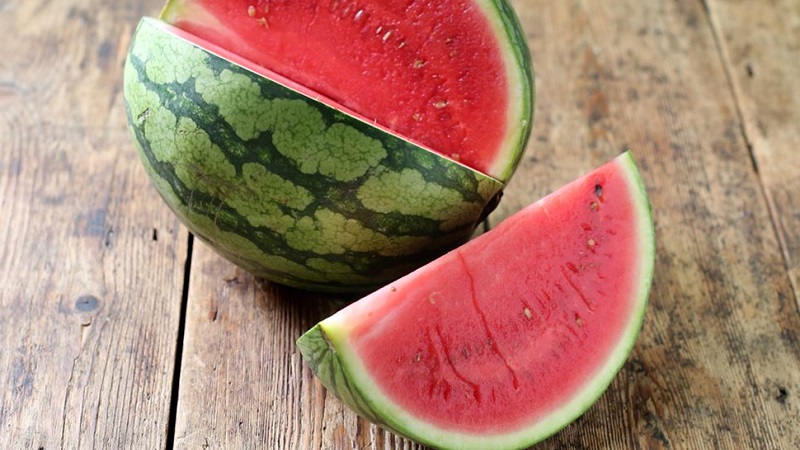
In the USSR, they were actively engaged in the development of new varieties... Astrakhan watermelons are still grown. In 1982, the pink variety Murashka was restored by Kamyshin breeders. The first Russian hybrid with raspberry pulp was VNIIOB 2 F1, which for many years was the leader among early watermelons. In 2015, the Honey Barrel variety with a pinkish core was patented.
French breeders have achieved great success... In 2010, a pink hybrid Silvia F1 and Charleston Gray with excellent palatability were registered.
One of the areas of selection is to obtain fruits with pulp of different colors.... Scientists cross table varieties with wild ones, producing watermelons that are pale pink and orange on the inside, but with a sweet taste.
What does it taste like
Pink-fleshed watermelons, like similar tomato varieties, contain less lycopene.... At the same time, the amount of acids decreases, and the proportion of sugars... The pink pulp of a ripe berry has a sweeter taste than red.
What is the difference between pink watermelon and red
The color of the pulp is given by special substances - carotenoids, which are also present in other colored fruits: tomatoes, carrots, peppers, apples. The red and pink colors are provided by lycopene. It also protects the pulp from early oxidative stress and UV rays.
The pulp contains various natural pigments:
| Name | Share |
| Beta carotene | 6% |
| Beta Cryptoxanthin | 1,3% |
| Lutein and Zeaxanthin | 0,1% |
| Lycopene | 90,6% |
Like lycopene other carotenoids perform important functions for plants:
- absorb part of the sun's spectrum that does not react with chlorophyll;
- resist oxidation;
- scatter excess sunlight.
All pigments color parts of the plant in shades of red of varying intensity.: from yellowish and orange to raspberry. They also determine the color of the watermelon seeds. Black seeds contain the maximum concentration of the dye.
Interesting. Spinach contains a large amount of carotenoids in the form of lutein - 12.06 mg per 100 g of product, which corresponds to three times the daily requirement for humans. However, its leaves remain dark green. This is due to the increased content of chlorophyll in the plant.
Characteristics, useful properties and composition of pink watermelon
An unripe fruit with a high nitrate content has a detrimental effect on the body and can cause severe intoxication. And special varieties with pink pulp are safe and have qualities valuable for the human body.

The fruit contains vitamins and amino acids:
| 100 g (mg) | Percentage of the daily value a person needs (%) | |
| Thiamine | 0,03 | 2 |
| Riboflavin | 0,02 | 1 |
| Pantothenic acid | 0,22 | 5 |
| Folic acid | 3 | 1 |
| Vitamin C | 8,1 | 9 |
| A nicotinic acid | 0,3 | 2 |
| Beta carotene | 303 | 6 |
The fruit contains important minerals:
| 100 g (mg) | Percentage of the daily value a person needs (%) | |
| Potassium | 64-338 | 9,4 |
| Silicon | 12 | 40 |
| Magnesium | 6-15 | 2,8 |
| Boron | 18 | 25 |
| Cobalt | 2 | 20 |
| Iron | 0,2-1 | 4 |
In small quantities, watermelon contains iodine, selenium, fluorine and other trace elements.
Regular consumption of fruits in August-September has a beneficial effect on the human body. Useful properties of the product:
- B vitamins and carotenoids improve vision;
- fiber cleanses the intestines from toxins;
- a large amount of water cleanses the body of toxins and prevents diseases of the urinary system, maintains the water-salt balance in the heat;
- lycopene - a powerful antioxidant, blocks free radicals, protects cell DNA, reduces the risk of cancer;
- potassium and magnesium strengthen the cardiovascular system.
Melons are included in diets slimming... 100 g contains only 0.15 g of fat - you can quickly fill up with watermelon without harming your figure.
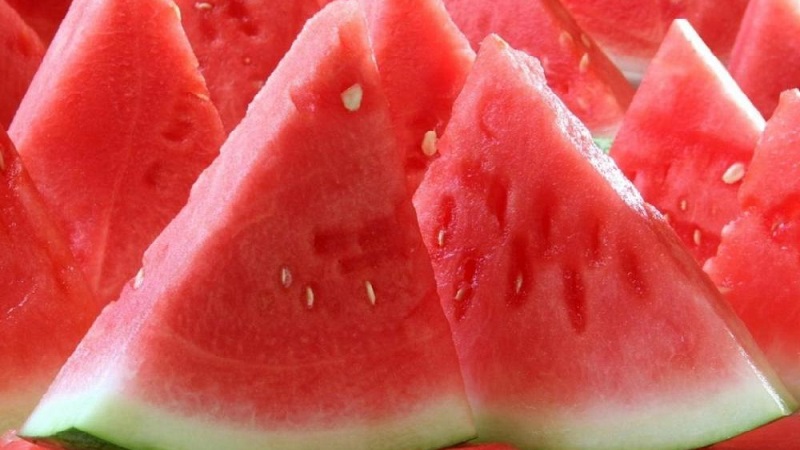
Harm and contraindications
Watermelon has contraindications associated with the high content of carotenoids and water in the pulp.
Do not recommend fruits in the following cases:
- with diseases of the urinary system, edema, kidney stone disease;
- if you are allergic to carotene;
- in case of disruption of the gastrointestinal tract;
- children under one year old;
- breastfeeding women until the baby is 2-3 months old.
The fetus affects bowel function - can cause diarrhea, bloating. A small child may have colic.
Important! It is dangerous for pregnant women to abuse watermelon. If the fruits may contain an increased amount of nitrates, which will adversely affect the health of the unborn child. In the last stages, eating large quantities of fruits can lead to edema. During this period, the urinary system can hardly cope with large volumes of fluid.
The main threat is nitrate fruits... When they are grown, increased doses of nitrogen fertilizers are used - this is how producers reduce the ripening time. When injected into the human body, nitrates block the blood's ability to carry oxygen, causing general intoxication.
Poisoning is accompanied by characteristic signs:
- nausea and vomiting;
- dizziness, general weakness;
- diarrhea.
Poisoning is especially dangerous for children, the elderly and pregnant women.
Main varieties and hybrids
As a result of selection, several pink varieties and hybrids of watermelon were bred... The main goal was not to obtain pink pulp, but to achieve commercially important qualities:
- sugar taste;
- keeping quality;
- ripening period;
- resistance to diseases, adverse weather conditions;
- safety during transportation.
Interesting fact. Recently, unusual varieties with yellow pulp have been bred. In Japan and China, square and rectangular fruits are grown - they are convenient for storage and transportation.
Early varieties
In central Russia, early hybrids are recommended for growing, which have time to ripen within 80 days. These include:
- Prince of Denmark F1... The plant forms fruits within 70-80 days. It is easy to recognize by its appearance: watermelons are spherical, dark green in color and bright pink flesh. The stripes are poorly visible and almost invisible. Sizes depend on growing conditions. The Danish prince can produce small fruits weighing 1.5 kg and giants up to 18-19 kg.
- VNIIOB 2 F1 (photo below). Fruits weighing up to 5 kg ripen together in 55-60 days. The pulp is pink in color with a high sugar content. The shape is rounded, slightly elongated.
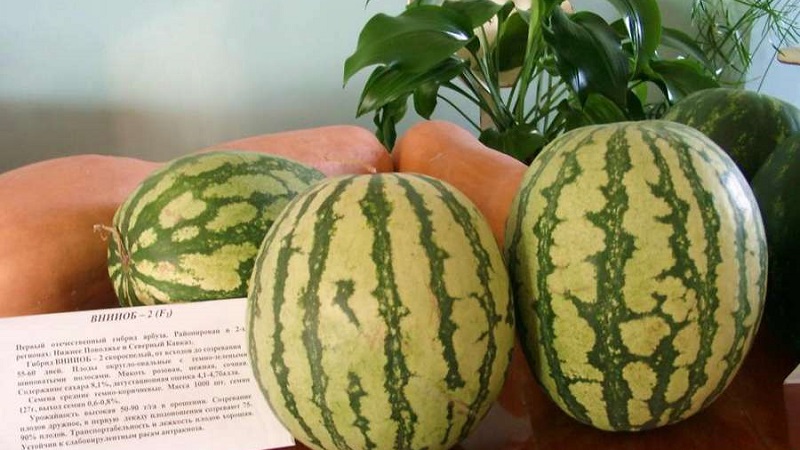
Mid-season
Watermelons that it takes 80-90 days to form a fetus:
- Silvia F1... Large rounded watermelons reach a weight of 12-15 kg. The pulp is deep pink in color. The hybrid has a thin crust and excellent taste.
- Big sugar... Watermelons weighing 10 kg ripen for 90 days. The pulp has a raspberry pink color and a sugar flavor. The shape of the fruit is round, slightly elongated.
Late
Cultivars that mature in 100-110 days have a firm and thick skin and can be stored for 2-3 months... Late watermelons are grown in the southern regions, they are demanding on weather conditions. Due to the long ripening period, the fruits contain an increased amount of sugars.
The most common:
- Icarus... Fruits weighing from 3 to 15 kg are slightly elongated. The rind is almost black with dark green stripes. Raspberry pulp with a strong aroma and excellent taste. The crop ripens in 100 days and can be stored for 3-4 months.
- Bush 334 (pictured below). The compact plant forms relatively small fruits up to 8 kg, disease resistant. Watermelons are green with whitish stripes. The pulp is bright pink, without streaks. The fruits can be stored until January.
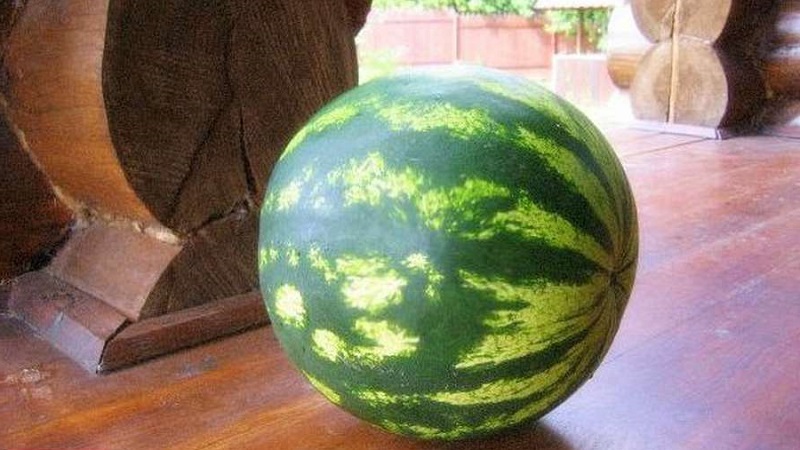
Zoned
Watermelon hybrids that can be grown in the middle lane and greenhouses:
- Champagne Pink F1 (photo below). Rounded fruits weighing up to 7 kg ripen in 70 days. The pulp is pinkish, with white streaks and a sugar flavor. Resistant to adverse weather conditions.
- Kai F1... Breeders bred this hybrid specifically for growing in the northern regions. The plant tolerates cool weather and lack of light. In 70 days, elongated cylindrical fruits with bright pink flesh have time to form. The weight of watermelons depends on the cultivation method: in the open field - 3-5 kg, in greenhouses - up to 10 kg.
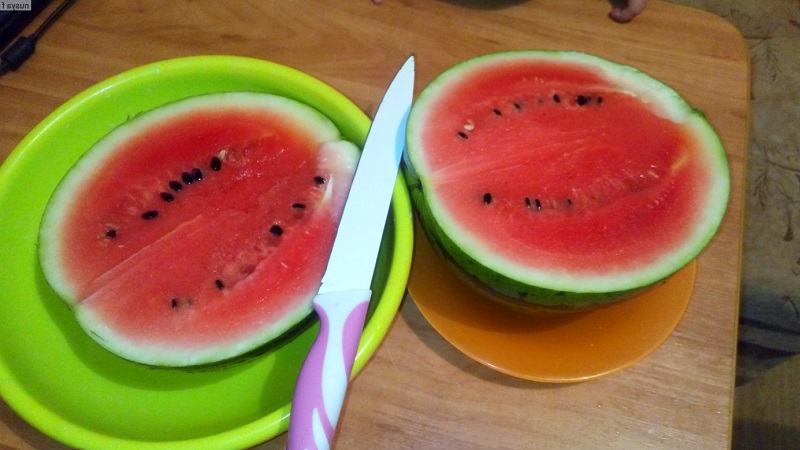
The sweetest
Hybrids with a high sugar content require hot and sunny weather. They are grown in the southern regions. The sweetest varieties include:
- Memory of Kholodov (photo below). The plant takes 110 days to form fruit. Watermelons are recognizable: the rind has no stripes and is colored light green. The pulp is bright pink, with few seeds and honey flavor.
- Crimson Sweet... Large fruits reach 12 kg and mature in 70 days. The pink sugar pulp contains small amounts of seeds. The plant is demanding on weather conditions, it is grown in the south.
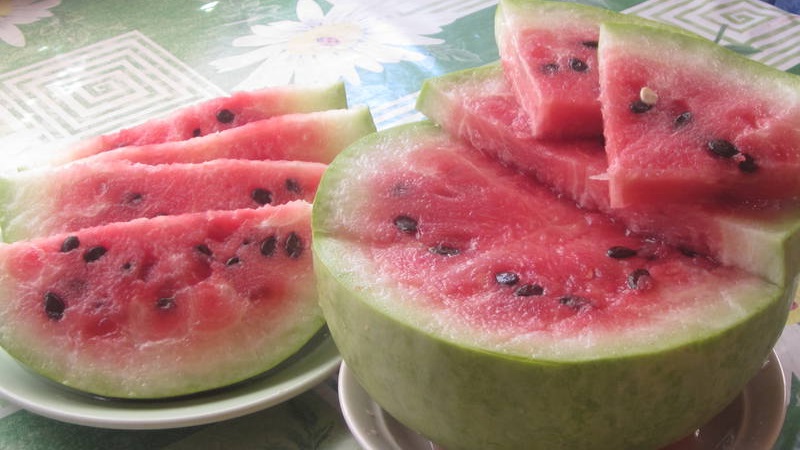
How to choose the right pink watermelon
When buying melons, check the signs confirming fetal maturity. Pink watermelon must have the following characteristics:
- dry tail;
- slight yellow spot;
- average size for its grade.
A dry tail means the fruit is fully ripe... Sometimes sellers remove it completely to hide a substandard product.
What if an ordinary watermelon turned out to be not red, but pink with white veins
In modern melon growing, varieties with light pink pulp and rough light fibers referred to as fodder. Such fruits have a herbaceous taste and are not suitable for human consumption.
Light pink pulp has unripe table varieties of watermelons... In such fruits, nitrogenous compounds did not turn into sugars.Often, light pink watermelons are received by gardeners in the middle lane after a rainy and cool summer. The plants did not receive enough sunlight to produce ripe and high-quality fruits. An additional feature is white seeds.
Is it possible to eat a watermelon if its flesh is pale pink
Whitish flesh indicates the immaturity of the fruit.... This watermelon will be tasteless and herbaceous. It is better to discard such fruit or feed it to livestock.
If you have saved your receipt, you can return the unripe watermelon to the store. This right is based on Art. 18 of the Law "On Protection of Consumer Rights", according to which the purchased goods must be of proper quality.
For melons, this means that the fruit must match the description of the botanical species. A ripe watermelon should have a rich pink or red flesh color.formed seeds. A fruit with pale pink flesh does not meet these requirements.
How to distinguish a good watermelon from a nitrate one
Signs that indicate a poor-quality product:
- purple shade of pulp;
- coarse yellow streaks;
- yellowish brown spots on the pulp;
- on the cut, the pulp is not sugary, but glossy;
- herbaceous taste.
To check the quality, you can shake a small amount of pulp in a glass of water... A poor-quality product will turn the liquid pink.
Conclusion
Pink watermelon is suitable for consumption if its pulp has a bright, rich color and sugar taste. This color is characteristic of several hybrids that are not inferior in quality to bright red varieties. However, fruits with pale pink flesh and watery taste are best avoided. They are immature and contain an increased amount of nitrogen compounds.